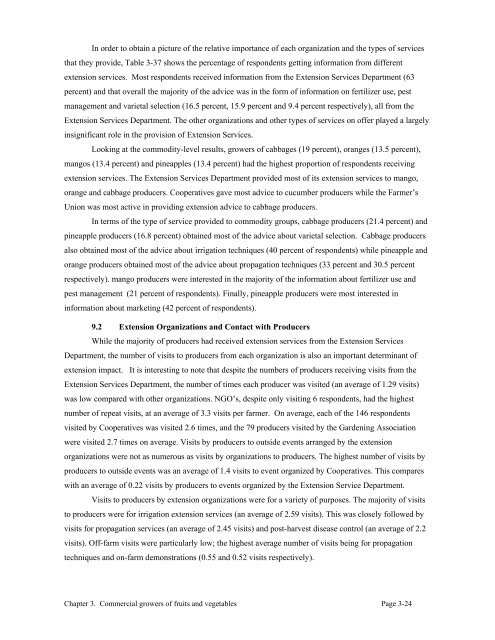Fruits and Vegetables in Vietnam - International Food Policy ...
Fruits and Vegetables in Vietnam - International Food Policy ...
Fruits and Vegetables in Vietnam - International Food Policy ...
Create successful ePaper yourself
Turn your PDF publications into a flip-book with our unique Google optimized e-Paper software.
In order to obta<strong>in</strong> a picture of the relative importance of each organization <strong>and</strong> the types of services<br />
that they provide, Table 3-37 shows the percentage of respondents gett<strong>in</strong>g <strong>in</strong>formation from different<br />
extension services. Most respondents received <strong>in</strong>formation from the Extension Services Department (63<br />
percent) <strong>and</strong> that overall the majority of the advice was <strong>in</strong> the form of <strong>in</strong>formation on fertilizer use, pest<br />
management <strong>and</strong> varietal selection (16.5 percent, 15.9 percent <strong>and</strong> 9.4 percent respectively), all from the<br />
Extension Services Department. The other organizations <strong>and</strong> other types of services on offer played a largely<br />
<strong>in</strong>significant role <strong>in</strong> the provision of Extension Services.<br />
Look<strong>in</strong>g at the commodity-level results, growers of cabbages (19 percent), oranges (13.5 percent),<br />
mangos (13.4 percent) <strong>and</strong> p<strong>in</strong>eapples (13.4 percent) had the highest proportion of respondents receiv<strong>in</strong>g<br />
extension services. The Extension Services Department provided most of its extension services to mango,<br />
orange <strong>and</strong> cabbage producers. Cooperatives gave most advice to cucumber producers while the Farmer’s<br />
Union was most active <strong>in</strong> provid<strong>in</strong>g extension advice to cabbage producers.<br />
In terms of the type of service provided to commodity groups, cabbage producers (21.4 percent) <strong>and</strong><br />
p<strong>in</strong>eapple producers (16.8 percent) obta<strong>in</strong>ed most of the advice about varietal selection. Cabbage producers<br />
also obta<strong>in</strong>ed most of the advice about irrigation techniques (40 percent of respondents) while p<strong>in</strong>eapple <strong>and</strong><br />
orange producers obta<strong>in</strong>ed most of the advice about propagation techniques (33 percent <strong>and</strong> 30.5 percent<br />
respectively). mango producers were <strong>in</strong>terested <strong>in</strong> the majority of the <strong>in</strong>formation about fertilizer use <strong>and</strong><br />
pest management (21 percent of respondents). F<strong>in</strong>ally, p<strong>in</strong>eapple producers were most <strong>in</strong>terested <strong>in</strong><br />
<strong>in</strong>formation about market<strong>in</strong>g (42 percent of respondents).<br />
9.2 Extension Organizations <strong>and</strong> Contact with Producers<br />
While the majority of producers had received extension services from the Extension Services<br />
Department, the number of visits to producers from each organization is also an important determ<strong>in</strong>ant of<br />
extension impact. It is <strong>in</strong>terest<strong>in</strong>g to note that despite the numbers of producers receiv<strong>in</strong>g visits from the<br />
Extension Services Department, the number of times each producer was visited (an average of 1.29 visits)<br />
was low compared with other organizations. NGO’s, despite only visit<strong>in</strong>g 6 respondents, had the highest<br />
number of repeat visits, at an average of 3.3 visits per farmer. On average, each of the 146 respondents<br />
visited by Cooperatives was visited 2.6 times, <strong>and</strong> the 79 producers visited by the Garden<strong>in</strong>g Association<br />
were visited 2.7 times on average. Visits by producers to outside events arranged by the extension<br />
organizations were not as numerous as visits by organizations to producers. The highest number of visits by<br />
producers to outside events was an average of 1.4 visits to event organized by Cooperatives. This compares<br />
with an average of 0.22 visits by producers to events organized by the Extension Service Department.<br />
Visits to producers by extension organizations were for a variety of purposes. The majority of visits<br />
to producers were for irrigation extension services (an average of 2.59 visits). This was closely followed by<br />
visits for propagation services (an average of 2.45 visits) <strong>and</strong> post-harvest disease control (an average of 2.2<br />
visits). Off-farm visits were particularly low; the highest average number of visits be<strong>in</strong>g for propagation<br />
techniques <strong>and</strong> on-farm demonstrations (0.55 <strong>and</strong> 0.52 visits respectively).<br />
Chapter 3. Commercial growers of fruits <strong>and</strong> vegetables Page 3-24
















